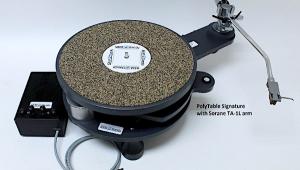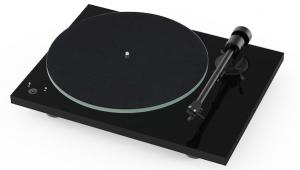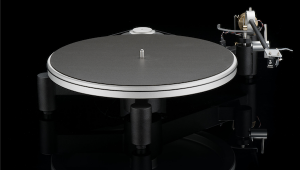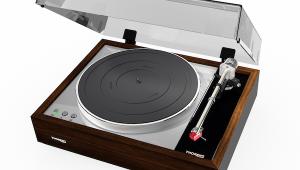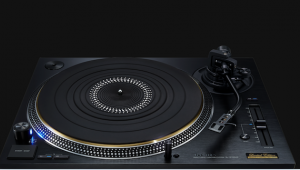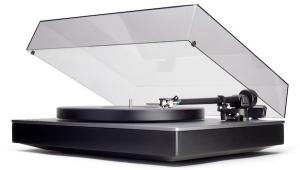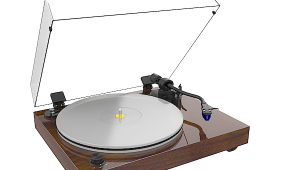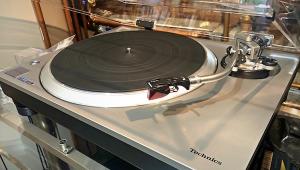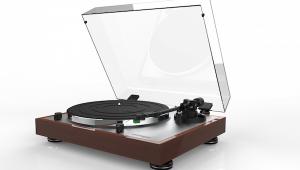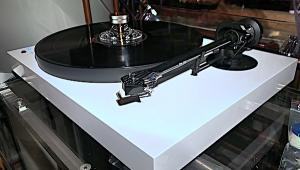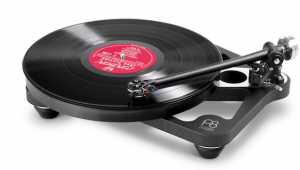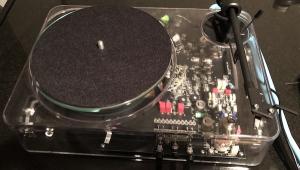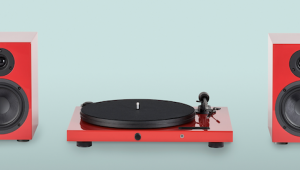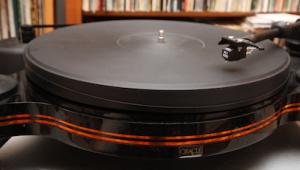The SME Model 20/3 Turntable: The Latest Variation on a Long Running Theme
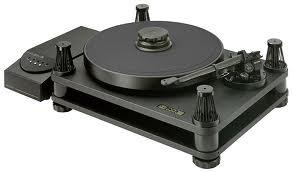
SME founder Alastair Robertson-Aikman was an audio hobbyist who one day decided to apply his engineering acumen and put to work the talented designers and machinists in his employ to produce a tone arm for his own use.
The rest, of course, is history, though it should be noted that today the company derives a good deal of its income machining, among other things, products for the medical industry.
When I visited the factory some years ago (and also got to spend some memorable time with the late Mr. Aikman), I watched the precision machining of wafer thin tungsten plates so difficult to produce that at the time the company had (and still might for all I know) a virtual monopoly on the process.
The various shaped plates are assembled in an iris-like device that’s used in a tumor irradiation machine. The operator can arrange and fan out the plates to the tumor’s precise shape so the radiation strikes only the cancerous area while protecting surrounding healthy tissue. This area of the factory was the only part in which photography was not permitted.
Following decades of tone arm manufacturing success, including in the 1980’s the introduction of the now iconic SME V, with it’s tapered arm tube of then exotic titanium and under slung counterweight, SME set its sights on designing an “ultimate” turntable.
In 1990, long after the CD had replaced vinyl as the medium of choice for all but a stubborn group of analog hold-outs, SME introduced the massive Model 30, a densely packed dual chassis, proudly metallic, four tower design featuring a multi-O ring suspension, a motor that sat on a separate chassis from the suspended one containing the platter, the bearing and the tone arm, and an electronic, three speed motor control.
Like the tone arm, the Model 30 was a revolutionary design and built to a fitn’n’finish level that had rarely, if ever, been seen in a turntable, thought some would argue that the Swiss company Thorens had done likewise earlier and for many years.
Over the years the design has been subtly modified, upgraded and re-sized to produce a less expensive model and ones enlarged to accommodate 12” tone arms, but overall it remains essentially unchanged and continues to be built to “heirloom quality” standards. Like the Porsche 911, why change radically when the basic design is so brilliant? In other words, like a Patek Phillipe watch, when your hearing goes south or you do, your son or daughter will inherit and continue using it.
There was a time but a few short years ago only lunatics thought their children might want a “hand me down” turntable and want to spin your old vinyl but of course we all know what’s happened! The chances are far greater your kids will want your vinyl and playback system than your CDs and CD player! I just love writing that! And love even more that it’s true!
The New, Not So New Model 20/3
Because the various SME models are so similar in design, rather than going through all of the basics yet again, I point you toward the review on this site of the SME 20/12 that originally appeared in my Analog Corner column in Stereophile SME20/12 review.
The new $12,000 20/3 (without tone arm, $15,500 as reviewed with SME Model V tone arm) is a variation on that theme, and though the technology and build quality are equal, the price is almost half that of the $28,000 20/12 (with arm).
Compared to the original Model 20, the 20/3 is more massive and has a superior suspension. In some ways it is a scaled down 20/12. Yet it still weighs approximately 63 pounds. It’s hardly a “lightweight.”
The sub-chassis measuring approximately 17”x13 ¾”x5/8” weighs twenty four pounds. The platter weighs approximately fourteen pounds. The forty O-ring suspended dual chassis design pays particular attention to vibrational energy dissipation that, according to SME, single chassis “closed loop” ones have greater difficulty achieving.
The motor is a 3 phase brushless design with 8 pole Neodymium magnets and 3 integrated Hall position sensors. The upgraded high performance electronic motor controller features an optimized microprocessor with fine pitch adjustment in increments of ±0.01%.
Suspended sub chassis designs such as this, where the motor sits on a different platform, inherently suffer from micro-belt flexing as the upper chassis is inevitably set in motion by the spinning platter, regardless of how well it’s machined. The micro-motion varies the distance between the platter and pulley, thus flexing the belt.
SME counters this with an improved centrally located fluid damper that both controls sub chassis motion and offers a resistive ground path for acoustical signals. The sub-chassis suspension itself consists of forty purpose-built molded “O” rings (ten per suspension tower) producing eighty suspension strands implemented in such a way as to be easily replaceable even while a record plays. Odds are you won’t have to change them for a long, long time, if ever.
The ¾ inch diameter main spindle, machined from high-chrome steel, hardened ground and “super finished” runs in a sealed oil bath that’s claimed to provide “lifetime lubrication.”
The platter features the same Isodamp surface (here in black) used on all SME turntables, that’s machined with a fine scroll said to optimize the record/platter interface. Heavy objects should not be placed upon the platter surface. Otherwise the SME 20/3 is built like the proverbial brick shit house and is essentially bullet-proof—as long as you don’t take that literally!
The Classic SME Series V Tonearm
SME American importer Sumiko supplied the ‘table with an SME V, first introduced in the 1980s. At the time, the SME V with its tapered die cast Magnesium arm tube (a one piece casting that included the head shell arm tube and counterweight stem), its superb fit’n’finish and overall design excellence created an amazing buzz. That it was then arguably the finest tone arm in the world was well accepted throughout the audiophile world.
The result was an ultra-stiff, mass optimized, self-damping arm tube (Magnesium has such properties) featuring internal high frequency constrained layer damping. Other parts of the arm are also pressure die-cast of zinc alloy to further prevent the transmission and production of unwanted vibrational energy.
17mm ABEC 7 radial shielded bearings and a “substantial” carrying yoke add to the arm’s impressive mechanical rigidity. Everything about the SME V was designed to transmit without loss the substantial vibrational energy produced at the stylus/record interface.
In fact, the arm’s ability to so transmit energy led some early users to conclude the arm was “bass heavy” when in fact the problem was that their turntables (particularly suspended ones) simply could not deal effectively with the generated energy reaching the arm’s base.
The main 23mm diameter arm pillar housing the vertical shaft and bearings and carrying the control bracket and anti-skating mechanism is machined from steel that’s heat treated, ground and honed.
The underslung counterweight housing incorporates a tungsten-alloy weight in a damped two-point suspension. The housing and the means by which the counterweight moves and can be locked down show more attention to detail than many tone arms of that period paid to their entire mechanisms!
Internal wiring is specially developed silver litz, each conductor having five insulated strands. The SME V’s fitn’n’finish of satin black enamel and black and bright chrome still sets the standard by which other tone arms are judged. Over the years the arm’s finish and build quality have only gotten better until today’s version is to quote John Lennon, “so good looking it’s so hard to see.”
Setting It Up
Setting up the ‘table should be relatively simple and for the most part if you follow the detailed instructions even a vinyl novice should have it up and running in a relatively short time.
It comes out of the shipping carton in one compacted unit, with the platter and suspension locked down for transport. Unlocking is relatively simple and straightforward except for one inexplicable error in the instructions that has been there for well over a decade.
A bolt inserted from the lower chassis’s underside secures the heavy motor casing, which is also sandwiched tightly between the upper and lower platforms.
After removing the bolt, but before you’re instructed to unclamp the suspension towers, you’re told to remove a thick paper spacer that’s between the motor and the lower platform. It’s impossible to do so without alo ripping the spacer. The instructions should tell you to first unlock the suspension, but for some reason that step comes later.
No big deal really, but if you are a “to the letter” instruction follower (I am) and if you have to later pack the ‘table for return, it will have you wondering. In any case, once the suspension towers have been freed and height-adjusted using the supplied spacer-gauge, the platter locking bolts removed, the platter screws freed from contacting the upper plinth, and the motor checked for positioning on its spiked feet within a platform indent, you’re close to being ready to take the turntable for a spin. All that remains is fitting the precision ground belt around the sub-platter and crowned motor pulley, plugging in the motor controller, adding oil to the bearing using a supplied accessory and then lowering the platter onto the sub-platter.
The SME V tonearm’s set-up is unique but relatively easy, particularly in terms of setting the overhang. Unlike most arms that include a slotted head shell that allows you to slide the cartridge forward and back to achieve correct overhang, the SME’s head shell has two round holes instead of slots. Your only option is to simply affix the cartridge to the head shell.
This makes cartridge installation quick and easy. Even easier is setting overhang: the entire arm slides fore and aft on geared tracks controlled by a key inserted in a side slot. Using a supplied plastic template that fits over the spindle, you slide the arm so that the stylus rests in a single concave point on the template, while when viewed from directly above, the arm matches its outline inscribed on the template.
There’s some subjectivity involved in the process but if you’re careful you can achieve ideal results.
The real benefit of this system is two-fold. First, you can pre-set the VTF (vertical tracking force) because it will not change as you set the overhang since the cartridge is not moving relative to the pivot and second, your fingers are not fiddling around in the “danger zone” near the delicate cantilever (you don’t even need a stylus pressure gauge [though I recommend one] because of the accuracy of SME’s built-in one).
The main problem with this system is that you cannot adjust zenith angle (the cantilever/stylus assembly’s “yaw” angle to the grooves). You have to hope the cartridge has been perfectly manufactured and that with overhang set correctly you’ve achieved tangentiality at the two “null points” along the stylus’s arc across the record.
Which brings up the alignment system’s other weak point: the single point alignment protractor does not give you a way to affirm null point tangentiality. However, using other gauges that do allow this, I’ve confirmed that SME’s system produces accurate settings assuming the cantilever isn’t skewed relative to the cartridge body.
There’s also no way to set azimuth, which in my opinion is a more serious issue since cantilever perpendicularity to the record surface is almost never a guaranty of proper azimuth angle and measurements show that even microscopic azimuth shifts produce easily audible results in terms of soundstage width and image solidity because azimuth shifts affect channel separation and therefor inter-channel crosstalk.
While VTA on the fly adjustability is also not possible, this is less of a problem because in my opinion once you’ve set VTA/SRA at 92 degrees you’re done, regardless of record thickness or phases of the moon.
Anti-skating is set via an easy to use numbered dial and adjusts via magnetic repulsion. Match the VTF number and you’re done. I used a test record (the out of print Telarc Omnidisc) and a Wally anti-skating gauge to check its accuracy and it is.
While making all of these adjustments, it will become clear that the SME arm’s machining precision and fit’n’finish is nothing less than Swiss watch-like. However, when the instructions tell you to set VTA/SRA by leveling the tone arm relative to the platter, you know you are stuck in an ‘80s time warp.
Using and Listening to the SME Model 20/3
If you know what you’re doing (and really, even if you don’t), you should be able to have the SME Model 20/3 and the SME V tone arm out of their boxes and set up within an hour or at most two using a process designed for both simplicity and stylus safety, even in the hands of a total novice.
SME turntables are among the least “fiddly” you’ll encounter among the “big rigs.” Nothing’s outboard and nothing dangles. Put a record on the platter, screw-down the clamp, push the button corresponding to the desired speed (including 78rpm) and you’re ready to lower the cueing lever and listen. The arm “handles” smoothly and precisely. Adjusting the speed using the supplied strobe is also precise and easy.
I ran the 20/3 with a variety of cartridges including the Ortofon A90 and Lyra Atlas and Titan, all three of which are very familiar to me.
As I found when reviewing the older and larger SME 20/12, the 20/3 sounded faster and more nimbly paced than the big Model 30, which, depending upon the rest of your system, can sound a bit thick and over-damped. The three words that most came to mind when listening to the 20/12 were “solid,” “stable” and “smooth.”
Measured speed stability using the Feickert 7” test record and Platter Speed iPhone app was excellent as expected and well-within the ±.3% window shown on the software’s measurement page.
For a suspended ‘table that offers superb isolation from the outside world, the SME 20/2 had solid, reasonably punchy, well-defined bass—something suspended turntables usually have in diminished quantities in exchange for background quiet. The SME 20/3 was quiet and had well-controlled and well extended bass and thus was rhythmically assured.
Up from there, the SME 20/3 was smooth and relatively uncolored through the midrange and up, though the mids were slightly pressed forward producing a bit of a “milky” sound relative to the best performing ‘tables, mostly priced higher. This resulted in less than the last degree of transparency
Whether because of the ‘table or the arm, the cartridges I used are capable of finer, better defined high frequency transients and greater spaciousness than I heard here but the comparison is using a reference turntable costing 10X the cost of the 20/3 SME V combo.
A fairer comparison would be with other ‘tables at this price point including models from TW Acustic and AVID, among others but unfortunately this process rarely offers that opportunity, which is one of the most frustrating parts of the job. Another strong contender at this price point is the AMG ‘table and arm combo from Germany that will soon be delivered for review.
Based upon possibly faulty sonic memory and to be taken with many grains of salt, I’d say greater transient speed and air was had with the AVID/SME combo I once reviewed, but at the expense of bass weight and solidity as well a slight edgy brightness versus the SME 20/3’s pleasingly smoothness.
Again, based upon possibly faulty sonic memory greater bottom end weight, solidity and overall backdrop quiet and transparency could be had from the TW Acustic ‘table. I wish it was possible to do “side-by-sides” but it’s not.
That said, nothing beats the all important “do you want to listen” test while another, far more expensive reference ‘table sits on the next rack. Some ‘tables make you want to listen to them and some you listen to because you have to.
The SME 20/3 was in the “makes you listen” category but not to the same degree as the $10K more expensive Spiral Groove SG 1.1 for instance that took rhythm’n’pacing to a higher level still.
Putting the SME Model 20/3 in Perspective
Though the bigger SME ‘tables are far more expensive, they are thicker and slower sounding than the faster, more nimble-sounding and least expensive in the line 20/3. The larger ‘tables may produce more weight and perhaps greater dynamic slam, but the 20/3 produces better overall rhythm’n’pacing and thus greater overall musical excitement.
Perhaps having amortized the basic design over decades of manufacturing SME can now sell a high quality, high performance ‘table like this at a far lower price point than previously but part of the reason for the price drop might also be the result of competitive pressure from other turntables at the same price point. This is not to suggest that $15,000 is anything less than a significant chunk of change!
The SME design is “mature” while other contenders that make use of modern composite materials and new thinking about bearing construction may achieve greater tonal neutrality, blacker backdrops, better impulse suppression and faster and more precise high frequency transient performance, all of which help propel the sonic picture further from the confines of the mechanical nature of the information retrieval involved in vinyl playback.
Despite its age, because of its ultra-high build quality and superior bearings, the SME V remains one of the premier tone arms currently available but the inability to adjust either azimuth or zenith angle limit its attractiveness to the more fastidious vinyl enthusiasts.
However, the SME 20/3 does perform at a very high sonic level overall. It has no weak sonic suits and its smooth and precise performance combined with ultra-stable speed and pitch accuracy produce both listening ease and compelling sonic satisfaction.
Its combination of set-up ease, mechanical stability (once set-up it’s going to stay that way indefinitely), ultra-high build quality and reliability make the SME 20/3 the ideal entry point for a well-heeled digital audiophile daring to make the plunge into analog.
Buy a 20/3 along with a stack of high quality new and reissued vinyl and chances are good you’re going to be hooked on LPs for good, while finding the playback process less onerous and time consuming than advertised by analog detractors. I say than confidently because I get the emails saying so all the time!
The “sweet spot” in most lines exists in the middle. Not so with the line of SME ‘tables. Leaving aside the Model 10, which is an entirely different design, I think the 20/3 is the “sweet spot” in the SME turntable lineup. It may not beat the bigger ‘tables in every performance parameter, but its overall sonic balance strikes me as the most attractive and of course so is the price.
That said, the SME 20/3 is more of an Aston-Martin style touring roadster than a track ready Formula 1 racer and there’s nothing wrong with that. For many music lovers, perhaps a majority that exist beneath the “chattering classes” of rabid audiophiles the SME 20/3 will be an ideal fit.


